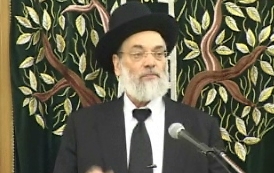Beit Midrash
- Family and Society
- The Jewish Household
- Marriage and Relationships
- Library-Sifria
- Emuna
Scripture offers two answers to this question, and these same responses carried through into rabbinic literature and Jewish law. In what follows we shall illustrate the existence of these answers and add a short ethical consideration in light of them.
Man and Woman in Scripture
One who reads the first two chapters of the Book of Genesis (according to the Masoretic division) will discover two accounts of creation. The first in chapter one, and the second in chapter two. These accounts are very different from one another. We shall illustrate by way of example.
In chapter one, creation is described as taking place in six days and coming to a close on the seventh; in chapter two, the event is described as taking place in a single day: "On the day that the Lord God made the earth and the heavens" (Genesis 2:4). In chapter one the sky was created first; in chapter two the earth was created first. In the first chapter, man is described as being created in the image of God; in the second chapter, the point of departure in man's creation is "dust of the earth"; and more.
In truth, these differences, and many more like them, derive from the fact that the two descriptions constitute two stages: The creation of the world, and its development. Chapter one describes the events of creation, and this being the case its account focuses on the transition from non-existence to existence. Chapter two provides a description of the world's formation and amelioration, and its point of focus is the transition from existence to improved existence.
We shall focus on the fundamental nature of the bond between man and woman as it is reflected in these two chapters. Let us begin with the description brought in chapter one: "So God created man in His own image, in the image of God created He him; male and female He created them" (verse 27).
This description is that of the creation of man - "adam" - as a single human being both male and female. This fact would appear to equate the word "adam" with a family unit, one consisting of male and female.
Immediately following their creation, their shared blessing and mission are mentioned: "And God blessed them, and God said to them: Be fruitful, and multiply, and replenish the earth, and subdue it; and have dominion over the fish of the sea, and over the birds of the air, and over every living thing that moves upon the earth." God blesses them with reproduction and world dominion.
Let us summarize, then, the values that underpin the man-woman bond here: The two of them together are called "adam," perhaps a kind of first family unit, and their task is continuity and the improvement of the world.
We now turn to the description in chapter two. Let us begin by underscoring the difference between the two chapters as regards the significance of the term "adam." In contrast to chapter one wherein this term defines the family unit or constitutes a name for the human race, in chapter two it relates to man in the singular, and the entire account takes on a person dimension.
The point of departure in the relationship between man and woman in chapter two is the fact that man alone is lacking - "It is not good that the man should be alone; I will make him a help to match him." Upon this backdrop, Scripture describes a process that begins with names being given to the entire animal world, continues with a deep sleep and the removal of part of adam's body, and ends with God presenting woman to man: "And the rib, which the Lord God had taken from man, made he a woman, and brought her to the man."
Finally, Scripture describes man's reaction, his admiration for woman: "And Adam said, ‘This is now bone of my bones, and flesh of my flesh; she shall be called Woman, because she was taken out of Man.’ "
What is the fundamental nature of the man-woman relationship according to this account? The point of departure described in these verses presents woman as a solution to an undesirable reality, man's state of loneliness. This fact presents the relationship between them not as being geared toward a particular purpose, but as essentially existential in nature.
It should further be noted that, theoretically speaking, woman could have served as man's helping companion just as well had she been created separately from him. In light of her having been taken from man's own body, their bond appears to imply a return to the point of origin, to the individual "adam" who comprised both of them before the separation. Now, however, their bond results from their free will and volition. (In Kabbalah, Jewish Mysticism, this is referred to as the "face to face" encounter, as distinct from the state of affairs before the separation, when their bond was "back to back.")
To summarize: In chapter two, the bond between man and woman takes the form of a response to man's miserable plight. This bond is described as an encounter that retrieves the Good, by reuniting man with a "bone from his bones, flesh from his flesh."
The verse that closes the biblical narrative indicates that a yearning for this reunion is embedded in the nature of man: "Therefore shall a man leave his father and his mother, and shall cleave to his wife; and they shall be one flesh."
Were we to attempt to define the relationship between these two chapters, we would arrive at the following picture:
Chapter one describes man's creation in the image of God. One blessing that comes with this is man's expanded existence on earth and over the generations, and another is a blessing for the conquest and improvement of the world - "Be fruitful and multiply, fill the land and conquer it." Note that although in this account man and woman work together, there is no treatment of the bond between them.
The second chapter embodies the bond as it finds expression in the form-taking realm, as an added layer of development. Here the focus is not man and woman’s creation as one per se, but on man's choosing this bond of his own volition, the Good that rests in this bond, the encounter between two wills, man's admiration for woman, and the return of the Good to man.
A wider probing of Scripture reveals these two types of bonds as existing under the surface of biblical narratives and various issues of Jewish law.
Man and Woman in Rabbinic Literature
The Talmudic tractate Kiddushin opens with a question regarding the relationship between two concepts: "Why is it written here 'a woman is acquired' while there it is written 'a man betroths'?" The question is, why does the first chapter of this tractate define the act of marriage as an act of acquisition (kinyan), while the second defines it as an act of betrothal (kiddushin)?
In order to understand the meaning of this question, we shall take a closer look at these two concepts. Acquisition is a legal device that defines the ownership of that which is bought, and the legal creation that is established following the act of acquisition. In our context, it is the home, the family.
The Talmud inquires regarding the significance of kiddushin, betrothal, and answers, "It makes her forbidden to the entire world like hekdesh (consecrated property)." What is the reason for likening kiddushin to hekdesh? At first glance the answer appears simple enough. Each of them involve a statement that creates an allocation, a setting apart (hekdesh, to God; kiddushin, to husband), and in each of them this allocation places a restriction upon the entire world.
However, is this comparison accurate? Unlike hekdesh, regarding which the prohibition applies to deriving benefit of any kind, in kiddushin the prohibition is limited to the arena of intimacy (ishut). Why, then, does the Talmud liken the two?
It would appear that the key to answering this question lies in the question itself. The act of kiddushin is indeed an act of consecration and designation, yet this does not apply to the entirety of the woman. Rather, it applies to her private or intimate dimension. It is not woman as an object (cheftza) to which this prohibition applies. The concept of "intimacy" is confined, through allocation, to the sphere of the bond between man and woman.
This perspective presents our two terms as forms of actualization of the two definitions already familiar to us from Scripture. The act of possession via kinyan (acquisition) belongs to the conceptual realm of Genesis' chapter one, to the creation of man as a general, non-personal concept. It takes us back to the blessing bestowed upon man to spread out over the land and over the generations, for the establishment of a home and a family serves as a form of this blessing's actualization.
The act of possession in kiddushin (betrothal), expressed in the words "You are hereby betrothed to me," is not in its essence a legal act in the sense of an acquisition. It takes us back to chapter two of Genesis, and sanctifies the relationship between man and woman, the substantive joining together as one, the exclusive bond.
Ethical Consideration
In what follows here we shall present a number of considerations regarding the existence of these two channels in life.
Firstly, it is essential to recognize that these are two different and distinct fields, and that each of them calls for thought, work, and devotion if it is to be imbued with due significance. The act of kinyan demands devotion to the home, to the family, to future generations and their education. The act of kiddushin demands thought and labor in order to deepen the bond, affection, to cause rejuvenation and shared growth.
There are couples for whom the central axis supporting their relationship is the home, the family, posterity. Other couples build their relationship by focusing on interpersonal bonding, on compatibility, as well as mental and spiritual attachment. In addition to the fact that, on an individual basis, people will emphasize one of these approaches more than the other, we also find that various communities and publics in the Jewish people tend to either the kinyan or kiddushin approach.
The existence of these differing perspectives is valid, "Both are the words of the living God" (Eruvin 13b), for each is grounded in the Scripture. At the same time, it should be pointed out that overemphasizing one while ignoring the existence of the other will not bear lasting fruit.
A relationship based upon affection without serious dedication to family values, to continuity, lacks true stability. Such a bond will inevitably encounter difficulties and will eventually collapse. On the other hand, personal attachment and affection are vital adhesives without which the home and the family could not be built.
-----
Translated biblical verses and/or Talmudic sources in the above article may have been taken from, or based upon, Davka's Soncino Judaic Classics Library (CD-Rom).

Stories from the Mikveh
Translated by Hillel Fendel
Various Rabbis | Tevat 10 5782

Is Your Kesubah Kosher?
Rabbi Yirmiyohu Kaganoff | Kislev 4 5777

The Seventh Blessing Re-examined
Rabbi Avraham Yitzchak HaLevi Kilav | 5764























